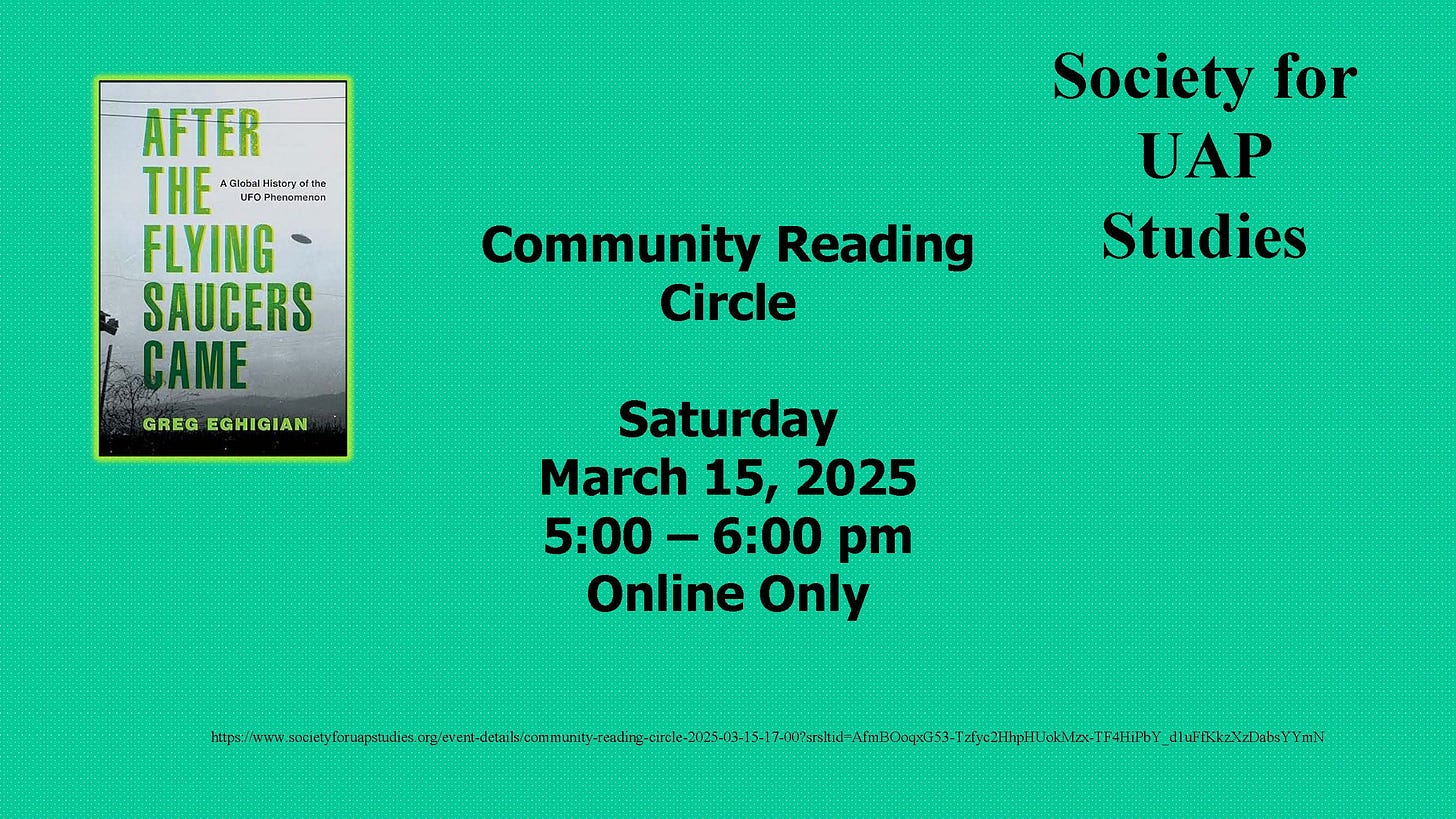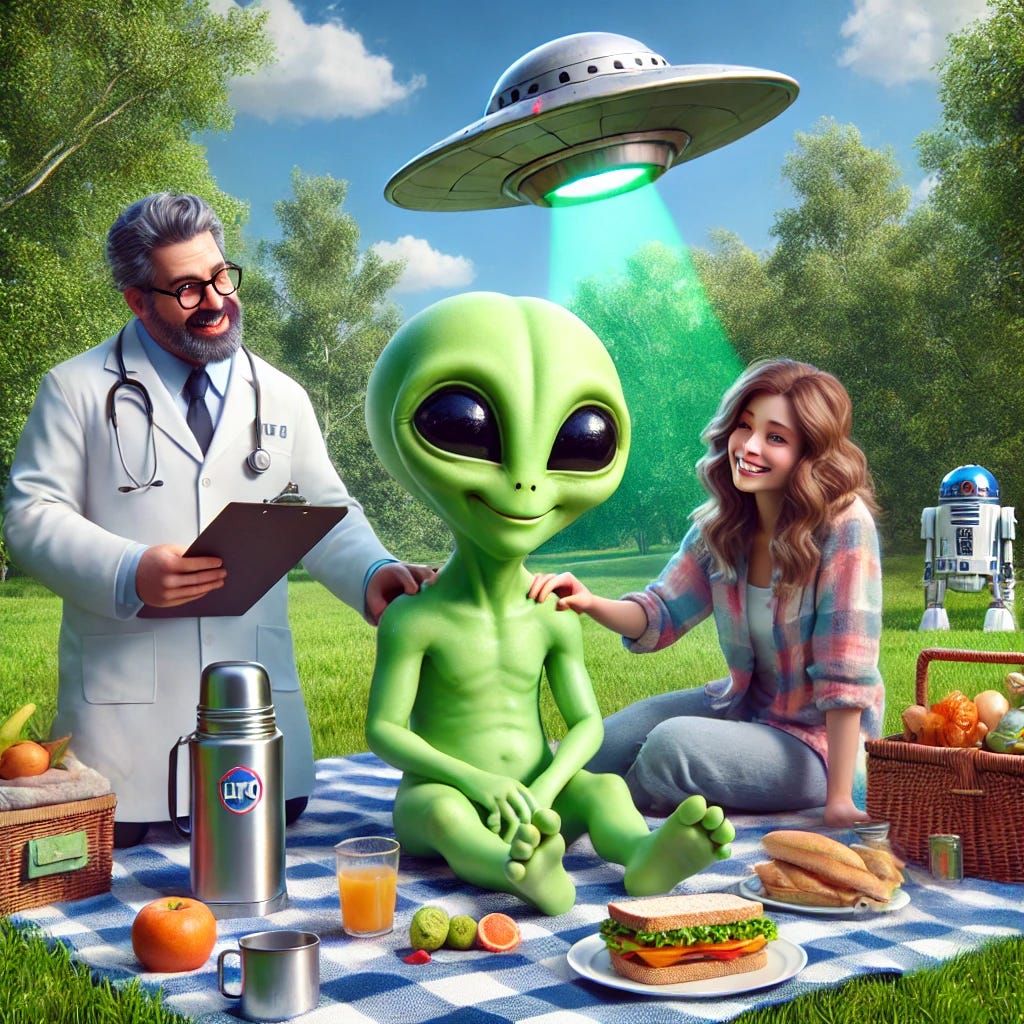I’m reading a most thoughtful recounting of the familiar UFO history from pre-1947 to date. It’s After the Flying Saucers Came: A Global History of the UFO Phenomenon, by Greg Eghigian (Eghigian 2024). In case you might be interested, this coming Saturday, March 15, 2025, the Society for UAP Studies will host a one-hour interview and discussion with its Dr. Eghigian. Register and join us online.
Here is a key passage in Eghigian’s book I’d like us to ponder.
“Many of those today seeking to legitimate the study of UFOs are intent on weeding out what they consider to be this unwanted cultural baggage from the phenomenon itself. The decision to replace the acronym UFO with the more generic UAP was done in the hope of accomplishing that. But this misses the point. The baggage is the phenomenon—or certainly as much as anything else can claim to be—and a name change will not divest it of its entanglements with politics and popular culture” (Eghigian 2024, 314).
Now I ask: just how do scientific methods and supra-scientific methods diverge or converge on the UAP mystery?
UFO science? No! But, wait!
For three quarters of a century, we’ve divided the populace into believers and disbelievers. Some of us believe UFOs are real. This assumes sub rosa that UFO believers also believe Earth is being visited by tourists from Zeta Two Riticuli or some other extraterrestrial civilization.
The monikers for most disbelievers are skeptic or debunker. Skeptics and debunkers typically appeal to the authority of science in order to consign UFO believers to pre-scientific atavism or superstition. The task of science should be to turn mysteries into materialistic explanations, and to do so with no-trespassing signs that keep out anything smacking or paranormal or religious implications.
The “Archdemon of Saucerdom” during the early decades was Harvard astronomer Donald H. Menzel. The claims of contactees and ufologists lay somewhere between implausible and absurd, contended this Ivy League debunker. Science provides no home for the unwarranted extraterrestrial hypothesis (Menzel 1952).
Harvard is different today. At home in Harvard’s astronomy department we find Avi Loeb, director of the Galileo project. The task of this project is to study UAP directly. And ETH is on the table. The task of the Galileo Project is “to collect scientifically rigorous, multimodal measurements using calibrated instruments to establish whether UAP represent a class of phenomena currently unknown to science” (Watters, Loeb and et.al. 2023, 38). UAP are now scientifically credible.
What had gone unnoticed from 1947 to 2017 is that ufologists largely thought of themselves as adhering to the objective values of science. The mission of MUFON (Mutual UFO Network), for example, has been to pursue the “Scientific Study of UFOs for the Benefit of Humanity.” But ufologists were largely amateurs with scientific aspirations. “Despite…rebuffs from the mainstream scientific world, ufologists continued to claim the mantle of science for themselves and their field of study,” observes Brenda Denzler (Denzler 2001, Kindle 1098). As I’ve frequently noted, ufologists did not receive invitations to barbecues with astrobiologists (T. Peters 2025). In the year 2017, ufology got an upgrade.
Science, yes. But Science Plus.
Since the 2017 New York Times article on the Pentagon’s mysterious UFO program, a sea change has taken place in UAP studies (Cooper, Blumenthal and Kean 2017). Chemist and UAP researcher Robert Powell notes how “attitudes toward UFOs have changed. This is demonstrated by the existence of organizations such as SCU [Scientific Coalition for UAP Studies] and GP [Galileo Project]. The rebranding of the word UFO to UAP was arguably instrumental in that change” (Powell 2024, 140). We’ve seen a leap in the number of white lab coats working on the phenomenon.
What scientists want is data. And scientists need instruments and experiments and measurements to get this data. “Instrumented field research has played a crucial role in establishing the scientific study of UAP,” observes Philip Ailleris (Ailleris 2024, 28).
When it comes to UAP Studies, however, scientific data is not enough. We need more. Why? Because the UFO phenomenon is a deep wakeless cultural phenomenon, not merely a scientific problem. Strange things seen in the sky are tied to a complex and nuanced history interweaving symbols, myths, philosophy, religion, politics, and the arts. The unidentified flying object engenders confusion and even transformation in the observing subject.
According to Christian Peters (no relation to me, as far as I know), “an increasing number of scholars in the social and cultural sciences now acknowledge that UAPs are far more than just unexplained physical objects in our skies and oceans” (Peters 2024, 7). We need more than science to study UAP. We need Science +.
Where do we go to study the supra-scientific dimensions of UAP?
UAP Studies as Science Plus
“UAP studies is not ufology,” declares Limina editor Michael Cifone. “UAP Studies is broader than both classical ufology and the nascent scientific study of UAP; it constitutes a richer conceptual landscape that is critical, empirical, and interpretative, applying the rigor of academic scholarship to UAP as well as the accounts surrounding them” (Cifone 2025, 6). Are UAP Studies scientific? Yes. But more.
Scientific inquiry “will not resolve all aspects of UAP,” Cifone claims (Cifone 2025, 1). Cifone wants to add hermeneutical and empirical methods to interpret experiential objects. As experiential objects, UAP include both objective and subjective dimensions.
In her Limina article, “The Importance of Phenomenology for UAP Studies,” Kimberly Engels emphasizes the foundational research status of subjective experience. Phenomenological methods begin by “taking the lived, first-person, conscious experience of the experiencing subject as our only natural access point to reality” (Engels 2025, 12). This includes, for Engels, the “intersubjective dimensions” of UAP encounter (Engels 2025, 22).
To interpret the UAP experience, the researcher may draw a tool from elsewhere in the toolbox of Husserlian phenomenology. Which tool? The bracket. The phenomenologist brackets out the reality question in order to attend to the experience itself. Temporarily, then, we set aside the question: is the UFO real?
Just why does bracketing the reality question help? Because we may wish to grasp just how UAP become manifested in human consciousness. In short, in addition to traditional scientific methods, UAP Studies will include phenomenological investigation into UAP as an experience.
We do not stop here. After bracketing out reality, we must at some point return to it. We must ask the ontological question. Not just about UAP. Rather, the ontological question as it pertains to everything real.
For many researchers with philosophical yearnings, the UAP question is simultaneously the reality question. Nothing less. The UAP experience collapses object and subject, perception and consciousness, matter and mind. Yet, pines Cifone, we have no mind-matter framework that bridges the physical and the psychical (Cifone 2025, 7). If the UFO investigator pursues a unifying theory to put mind and matter back together again, for all intents and purposes we are pursuing being itself.
This leads UAP researchers such as Brenda Denzler (Denzler 2001), Jensine Andresen (Andresen 2023), and Jeffrey Kripal (Kripal 2024) to dive like an Olympian into the depths of ontology. Each of these three scholars in their respective ways explores a supra-scientific worldview that incorporates human subjectivity along with scientific objectivity set within a unifying metaphysical scheme.
FYI: should you wish to extend the discussion of the interaction between science and religion within the UFO phenomenon, see the video interview, “Religion + UFPs?,” on Coffee and UFOs with Alan Smith and Ted Peters.
Conclusion
UAP Studies needs rigorous and fertile scientific study, to be sure. But UAP Studies needs more. This field needs Science Plus.
It would be fallacious to assume that science is the only path to reality, the only path to explain UAP. It would be a mistake to write off at the level of assumption dimensions that involve consciousness or even that seem to include the paranormal. These belong to the UFO phenomenon itself, as Eghigian rightly observes.
My own work in UAP studies has sought to explicate for analysis not only the scientific but also the political, cultural, and religious dimensions of the phenomenon. So I resonate positively with Greg Eghigian’s treatment of UAP history.
Substack SR 1198, UFO 28. UFOs, UAP, and Science Plus
UAP’s Cryptoterrestrial Hypothesis
UFO 18 Are UAP from outer space?
UFO 19 Are UAP from future time?
UFO 20 Are UAP Extradimensional?
UAP and Ancient Alien Theology
UAP, ETI, and David Bohm's Physics
▓
Ted Peters directs traffic at the intersection of science, religion, and ethics. Ted is an emeritus professor at the Graduate Theological Union, where he co-edits the journal, Theology and Science, with Robert John Russell on behalf of the Center for Theology and the Natural Sciences, in Berkeley, California, USA.
In the field of Ufology, Ted served one stint as Louisiana State Director of Investigations for MUFON. Currently he holds active membership in the Society for UAP Studies and the Scientific Coalition for UAP Studies. He is author of UFOs: God's Chariots? Spirituality, Ancient Aliens, and Religious Yearnings in the Age of Extraterrestrials (Career Press New Page Books, 2014).
His theme volume is The Voice of Public Theology, a collection of previous articles. See his website: TedsTimelyTake.com.
▓
References
Ailleris, Philip:. 2024. "Exploring Unidentified Aerospace Phenomena through Instrumented Field Studies: Historical Insights, Current Challenges, and Future Directions." Limina 1:1 11-30; chrome-extension://efaidnbmnnnibpcajpcglclefindmkaj/https://img1.wsimg.com/blobby/go/82b7e4a9-8ca9-40a3-b45b-0dfcce8fdd22/downloads/Limina%20Volume%201%202024%20(TOC).pdf?ver=1717628475160.
Andresen, Jensine. 2023. Bohm's Interpretation of Quantum Theory: Implications for Extraterrestrial Intelligence (ETI) and Unidentified Anomalous Phenomena (UAP). New York: Andresen.
Cifone, Michael C. 2025. "Editorial." Limina 2:1 6-11. https://limina.scholasticahq.com/article/131857-editorial.
Cooper, Helene, Ralph Blumenthal, and Leslie Kean. 2017. "Glowing Auras and ‘Black Money’: The Pentagon’s Mysterious U.F.O. Program." New York Times, December 16: A1; https://www.nytimes.com/2017/12/16/us/politics/pentagon-program-ufo-harry-reid.html .
Denzler, Brenda. 2001. Lure if the Edge: Scientific Passions, Religious Beliefs, and the Pursuit of UFOs . Berkeley CA: University of California Press.
Eghigian, Greg:. 2024. After the Flying Saucers Came: A Global History of the UFO Phenomenon. Oxford: Oxford University Press.
Engels, Kimberly S: 2025. “The Importance of Phenomenology for UAP Studies,” Limina 2:1:12-22. https://limina.scholasticahq.com/article/131704-the-importance-of-phenomenology-for-uap-studies.
Kripal, Jeffrey. 2024. , How to Think Impossibly: About Souls, UFOs, Time, Belief, and Everything Else . Chciago: University of Chicago Press.
Menzel, Donald H. 1952. "The Truth about Flying Saucers." Look, June 17: 35-39. https://www.project1947.com/fig/look61752.htm.
Peters, Christian. 2024. "UAPs and AI: Socio-Cultural Perspectives on a Complex Relationship." SCU Review 5:4 7-13; https://www.explorescu.org/post/scu-review-5-4.
Peters, Ted. 2025. "One Science for both Astrobiologists and Ufologists." Limina 2:1 93-100. https://limina.scholasticahq.com/article/131694-one-science-for-both-ufologists-and-astrobiologists.
Powell, Robert. 2024. UFOs: A Scientist Explains What we Know and Don't Know. Lanham MD: Roman and Littlefield.
Watters, Wesley, Abraham Loeb, and et.al. 2023. "The Scientific Investigation of Unidentified Aerial Phenomena (UAP) Using Multimodal Ground-Based Observatories." Journal of Astronomical Instrumentation 12:1 1-43; DOI: 10.1142/S22511717234000682340006-1.








